A systematic genetic screen identifies essential factors involved in nuclear size control
- PMID: 30759079
- PMCID: PMC6391033
- DOI: 10.1371/journal.pgen.1007929
A systematic genetic screen identifies essential factors involved in nuclear size control
Abstract
Nuclear size correlates with cell size, but the mechanism by which this scaling is achieved is not known. Here we screen fission yeast gene deletion mutants to identify essential factors involved in this process. Our screen has identified 25 essential factors that alter nuclear size, and our analysis has implicated RNA processing and LINC complexes in nuclear size control. This study has revealed lower and more extreme higher nuclear size phenotypes and has identified global cellular processes and specific structural nuclear components important for nuclear size control.
Conflict of interest statement
The authors have declared that no competing interests exist.
Figures

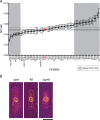
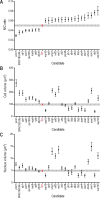
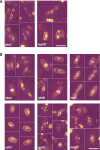
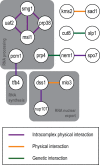
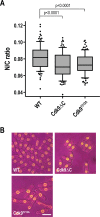
Similar articles
-
Unravelling nuclear size control.Curr Genet. 2019 Dec;65(6):1281-1285. doi: 10.1007/s00294-019-00999-3. Epub 2019 May 31. Curr Genet. 2019. PMID: 31147736 Free PMC article. Review.
-
A systematic genomic screen implicates nucleocytoplasmic transport and membrane growth in nuclear size control.PLoS Genet. 2017 May 18;13(5):e1006767. doi: 10.1371/journal.pgen.1006767. eCollection 2017 May. PLoS Genet. 2017. PMID: 28545058 Free PMC article.
-
Involvement of fission yeast Pdc2 in RNA degradation and P-body function.RNA. 2017 Apr;23(4):493-503. doi: 10.1261/rna.059766.116. Epub 2016 Dec 28. RNA. 2017. PMID: 28031482 Free PMC article.
-
Nuclear retention of fission yeast dicer is a prerequisite for RNAi-mediated heterochromatin assembly.Dev Cell. 2010 Jan 19;18(1):102-13. doi: 10.1016/j.devcel.2009.11.011. Dev Cell. 2010. PMID: 20152181
-
TFIIIC boxes in the genome.Cell. 2006 Jun 2;125(5):829-31. doi: 10.1016/j.cell.2006.05.016. Cell. 2006. PMID: 16751090 Review.
Cited by
-
Control of nuclear size by osmotic forces in Schizosaccharomyces pombe.Elife. 2022 Jul 20;11:e76075. doi: 10.7554/eLife.76075. Elife. 2022. PMID: 35856499 Free PMC article.
-
A quantitative and spatial analysis of cell cycle regulators during the fission yeast cycle.Proc Natl Acad Sci U S A. 2022 Sep 6;119(36):e2206172119. doi: 10.1073/pnas.2206172119. Epub 2022 Aug 29. Proc Natl Acad Sci U S A. 2022. PMID: 36037351 Free PMC article.
-
High-Throughput Identification of Nuclear Envelope Protein Interactions in Schizosaccharomyces pombe Using an Arrayed Membrane Yeast-Two Hybrid Library.G3 (Bethesda). 2020 Dec 3;10(12):4649-4663. doi: 10.1534/g3.120.401880. G3 (Bethesda). 2020. PMID: 33109728 Free PMC article.
-
Larger cells have relatively smaller nuclei across the Tree of Life.Evol Lett. 2021 Jun 29;5(4):306-314. doi: 10.1002/evl3.243. eCollection 2021 Aug. Evol Lett. 2021. PMID: 34367657 Free PMC article.
-
Regulation of diverse nuclear shapes: pathways working independently, together.Commun Integr Biol. 2021 Jul 5;14(1):158-175. doi: 10.1080/19420889.2021.1939942. eCollection 2021. Commun Integr Biol. 2021. PMID: 34262635 Free PMC article. Review.
References
-
- Hertwig R. Ueber die Korrelation von Zell-und Kerngrösse und ihre Bedeutung für die Geschlechtliche Differenzierung und die Teilung der Zelle. Biologisches Centralblatt. 1903(23):4–62.
-
- Boveri T. Zellenstudien V. Über die Abhängigkeit der Kerngrösse und Zellenzahl bei Seeigellarven von der Chromosomenzahl der Ausganszellen. Jenaische Zeitschrift für Naturwissenschaft. 1905;39:445–524.
-
- Wilson EB. The Cell in Development and Heredity. 3 ed. New York: Macmillan; 1925.
-
- Gregory T. Genome size evolution in animals In: Gregory T, editor. The Evolution of the Genome. London: Elsevier Academic Press; 2005. p. 4–87.
-
- Conklin EG. Cell size and nuclear size. Journal of Experimental Zoology. 1912;12(1):1–98.
Publication types
MeSH terms
Grants and funding
LinkOut - more resources
Full Text Sources
Other Literature Sources
Molecular Biology Databases

